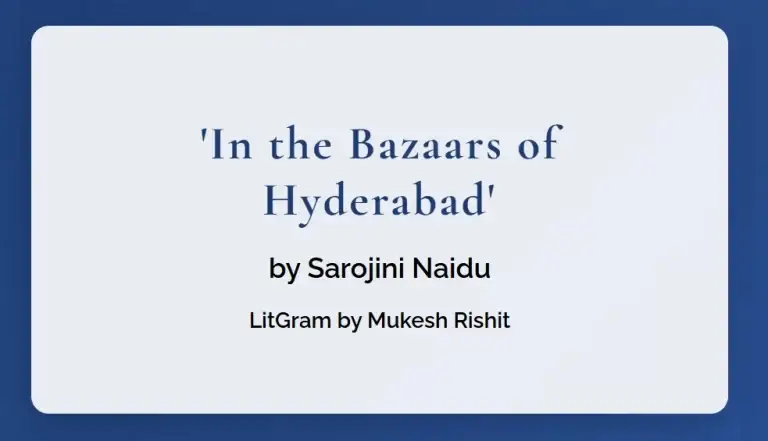Introduction: A Window into the Bazaars of Hyderabad
What comes to mind when you think of a bustling bazaar? The aroma of spices, the glint of hand-crafted jewelry, the call of merchants haggling in melodious tones? This enchanting atmosphere is captured beautifully in “In the Bazaars of Hyderabad,” a poem by Sarojini Naidu. Often referred to as the “Nightingale of India,” Sarojini Naidu’s poetry reflects vivid imagery, rich culture, and an exquisite blend of Indian traditions.
Hyderabad, the city of pearls, is famous for its historical bazaars that have stood the test of time. Naidu’s poem immortalizes these bazaars, transforming them into a lyrical canvas that celebrates India’s vibrant heritage. But what makes this poem—and the bazaars it describes—so unique? Let’s delve into the literary brilliance of the poem, the elements it highlights, and the real-life inspiration behind it.
Exploring the Poem: A Closer Look
1. About Sarojini Naidu
Sarojini Naidu was more than just a poet. Born in 1879 in Hyderabad, she was also a freedom fighter and one of the leading figures in India’s independence movement. Known for her lyrical poetry and eloquence, she gained acclaim as the “Nightingale of India.” Through her writings, she conveyed India’s pride, beauty, and culture, often drawing inspiration from everyday Indian life.
Her poem “In the Bazaars of Hyderabad” showcases her ability to blend art and activism by celebrating indigenous culture during a time of British colonial rule. It’s a gentle yet powerful reminder of India’s rich heritage, offering readers a virtual exploration of one of the most famous bazaars in the country.
2. The Historical Role of Indian Bazaars
Traditional Indian bazaars have always been more than just places of commerce; they’ve been hubs of community, culture, and creativity. Whether it’s the local tradesmen hawking their wares or the vibrant exchange of stories and traditions, bazaars have played an integral role in shaping Indian society. Sarojini Naidu’s poem mirrors this dynamic, showing how each seller contributes to the marketplace’s harmonious rhythm.
3. Overview of the Poem’s Theme
At first glance, “In the Bazaars of Hyderabad” is a descriptive poem cataloging various items sold in a marketplace. However, its central theme runs deeper. Beyond the physical wares—the spices, the jewels, the flowers—it paints a picture of India’s cultural heritage. Naidu also subtly underscores themes of independence and self-reliance, championing the goods crafted by local artisans over mass-produced imports by colonial powers.
4. Line-by-Line Analysis
One of the standout features of the poem is Naidu’s ability to bring the bazaar to life. Let’s look at a few lines:
- “What do you sell, O ye merchants?” Naidu begins with a direct address, almost conversational in tone, instantly drawing the reader into the bustling marketplace.
- “Richly your wares are displayed” The poet describes the merchants’ goods with rich adjectives, creating a vibrant visual layout.
- “What do you make, O ye goldsmiths?” As the questions continue, readers feel like active participants in the marketplace. Each stanza introduces a slice of life—a different occupation, a tapestry of color, smell, and sound.
5. Cultural Significance
The poem serves as both a celebration and a preservation of Indian traditions. It highlights the intricacies of craftsmanship—whether it’s the goldsmiths designing ornaments, the fruit sellers arranging plans, or the spice merchants scenting the air with their wares.
6. The Living Heritage of Hyderabad’s Bazaars
Take a stroll through Hyderabad today, and you’ll still find echoes of Naidu’s poem. Laad Bazaar, for instance, is famous for its stunning bangles and traditional jewelry. Begum Bazaar, on the other hand, is a treasure trove for those seeking antiques or Indian perfumes. These bustling markets continue to thrive, blending old-world charm with modern energy.
7. Imagery and Symbolism
Naidu’s mastery of sensory imagery is unparalleled. Can’t you almost hear bells tingling on anklets or see the shimmer of crimson turbans in the marketplace? The poem isn’t just a description—it’s an experience.
8. Symbolism of Local Goods
By focusing on the artisans and their wares, “In the Bazaars of Hyderabad” symbolizes self-reliance and independence. It’s as if Sarojini Naidu is swooning over homegrown products while encouraging readers to reject colonial imports.
9. The Role of Women
Though subtle, the woman’s presence in both the poem and the bazaar is poignant. They form the heart of both commerce (as sellers) and culture (as buyers). Naidu’s poetry vindicates women as central figures in the celebration of tradition and art.
10. The Timeless Connection
Even generations later, “In the Bazaars of Hyderabad” reminds us to honor our roots. In an era where fast-paced urban life threatens to overshadow local art, the poem brings nostalgia and pride, urging us to preserve these pockets of cultural vibrancy.
Conclusion
“In the Bazaars of Hyderabad” isn’t just a poem—it’s an ode to Indian heritage, an intricate portrait of a marketplace teeming with life, color, and emotion. It reiterates the importance of valuing local artisans and cherishing cultural traditions. As you explore the bustling markets of any Indian city today, you can almost hear Sarojini Naidu’s lyrical questions echoing in the air: “What do you sell, O ye merchants?”
By drawing from real-life Hyderabad bazaars, Naidu immortalized their splendor while leaving behind a literary gem that continues to resonate across eras.
FAQs
1. Who wrote “In the Bazaars of Hyderabad”?
The poem was written by Sarojini Naidu, also known as the “Nightingale of India.”
2. What is the theme of the poem?
The central theme is the celebration of India’s cultural richness, artisanal skill, and the vibrancy of traditional Indian marketplaces.
3. Where is Hyderabad’s Laad Bazaar?
Laad Bazaar is located near the iconic Charminar and is famous for its bangles, jewelry, and traditional goods.
4. Why is Sarojini Naidu important in Indian history?
Apart from being a celebrated poet, she was a prominent freedom fighter and the first woman to serve as the President of the Indian National Congress.
5. What made Indian bazaars unique during Naidu’s era?
Indian bazaars were (and still are) vibrant hubs for handmade goods, fresh produce, spices, and local craftsmanship, symbolizing India’s artistic and cultural legacy.


